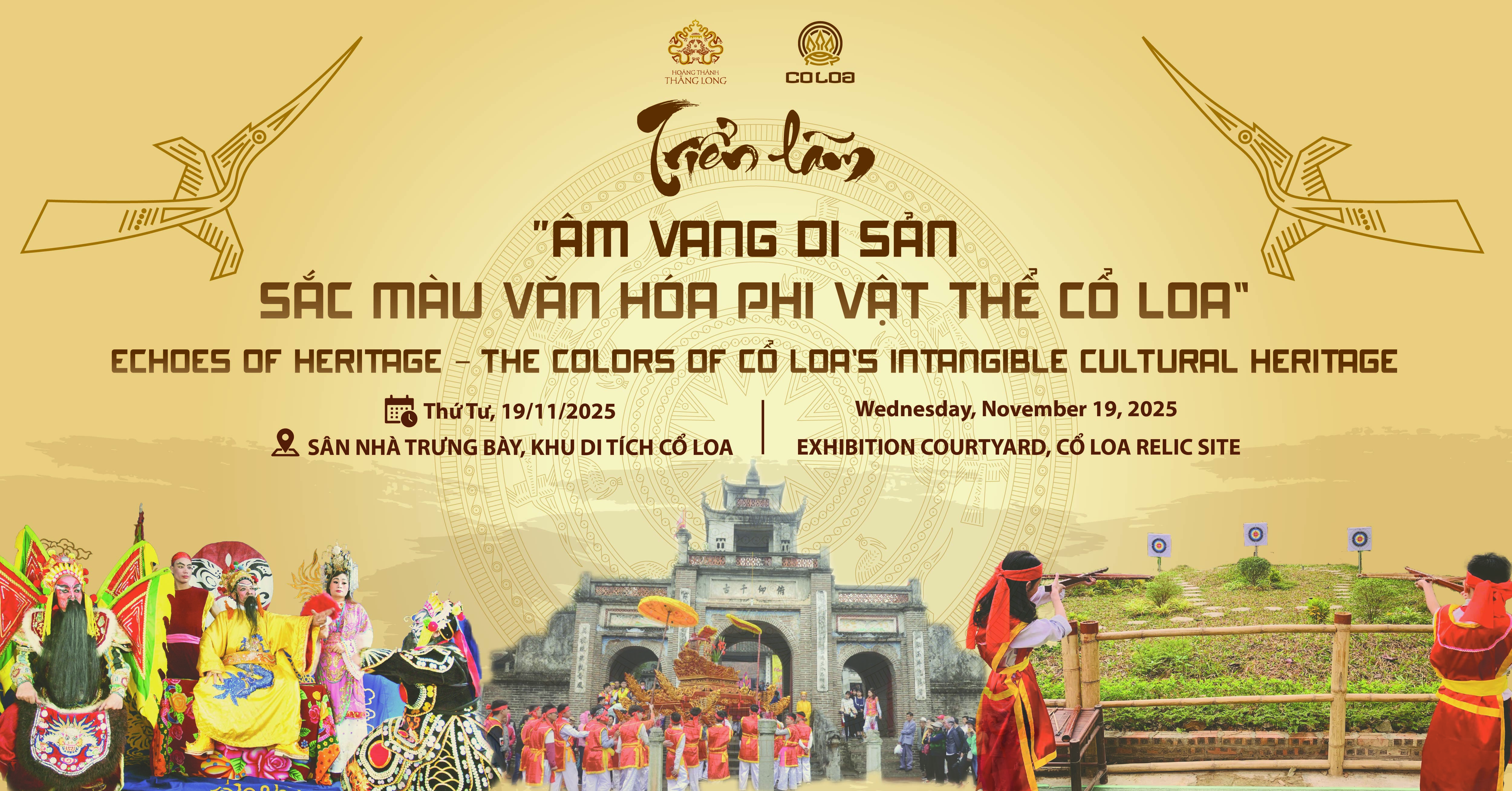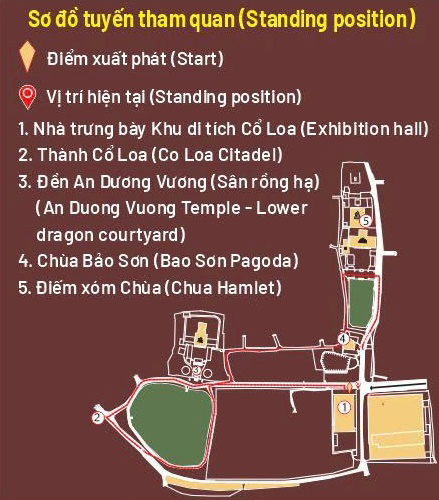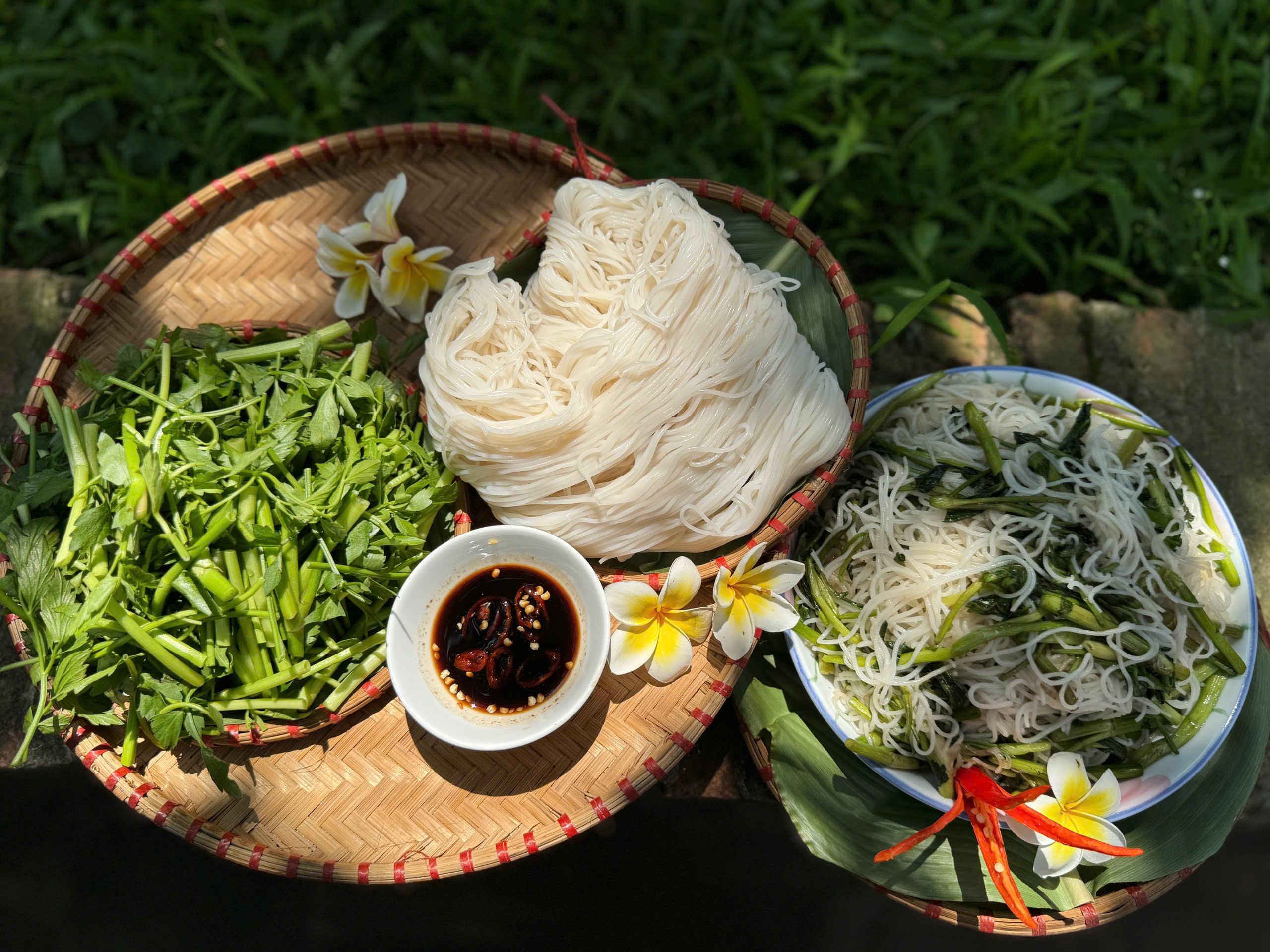
Quậy village which are three villages in Lien Ha commune today also called Hà Vi: Quậy Cả (Đại Vĩ), Quậy Rào (Giao Tác), Quậy Sau (Châu Phong). Before the August Revolution of 1945, it belonged to Hà Lỗ, Đông Ngàn district, Từ Sơn town, Bắc Ninh province.
 Reading the oration Ritual
Reading the oration Ritual
According to legend, the Quậy villagers today are the original Cổ Loa residents. The story is that after the 18th King Hùng Vương passed the throne, An Dương Vương changed the capital from the Bạch Hạc – Việt Trì area to the delta region and ordered the villagers of Chạ Chủ to move to Hà Vĩ to establish a new village. This is a village at the end of the river ("Ha" - river, "Vi" - tail). Therefore, the name of the village "Quậy" is a misnomer for the word "cuối” (end), which is a lowland area, where the water is located.
Because the Quậy villagers are of Cổ Loa origin, they are respected as "elder brothers". Every year, on the Cổ Loa festival on January 6, they are invited to pray to the King and perform the ceremony on the upper mat. When Cổ Loa village established Sa market, the Quậy villagers did not have to pay taxes when coming to the market. After many other villagers impersonated themselves as "Quậy villagers", the elders of the village asked Cổ Loa village to abolish this custom.
The land where the three villages of Quậy village were moved according to the king's orders is low land in Đông Anh district (from 3 to 6 meters above sea level). In the past, there was a folk saying: “Quậy ủ Chủ tươi, Quậy cười Chủ khóc”, meaning that when the people of Quậy village were sad because of crop failure due to the low terrain of the fields causing flooding, the people of Chạ Chủ were happy because of the good harvest, due to the high-field terrain. On the contrary, when it rains moderately, the Quậy area has a good crop, while Chạ Chủ has a poor crop.
Quậy village festival is associated with the image of ancient Hà Vĩ communal house. The history of construction and development of Ha Vi communal house is directly related to the construction of the citadel by King An Dương. According to the remaining Hán Nôm documents, the communal house was built in the year Canh Thìn, the reign’s years of Quang Thiệu, the reign of King Lê Chiêu Tông (1520) on the foundation of the old temple; It was revised in the year of Giáp Tý, in the reign’s years of Cảnh Hưng (1744) and rebuilt on the same scale as today in the year of Canh Tý, in the reign’s years of Thành Thái (1900). The communal house faces west, in front of it are Rậy fields and a lake. This is one of the largest communal houses in the region, with the structure of the shape of Chinese word "工". The great communal house consists of seven rooms and two doors with a total length of approximately 30 meters. The diameter of the largest column is 0.85 meters, the smallest column is 0.65 meters. In the communal house, there is an illuminated “cửa võng” (wooden decorative border), carved with a lively and sophisticated theme of "four supernatural creatures, four seasons". In addition, the decorative border also features orchids, flowers, and dragon horses. On the top are embossed four words "Thánh cung Vạn tuế". With massive architecture in the style of the late Lê and early Nguyến dynasties, Hà Vĩ communal house is a unique architectural work, demonstrating the traditional carpentry of the Quậy villagers.
Every year, on the 12th day of the first lunar month, the people of Quay village organize a festival to commemorate the merits of the village tutelary gods. Those are 5 generals: Thủy Hải, Đăng Giang, Khổng Chúng, Thánh Tam Giang and Đông Hải Đại Vương, all heroes who have defended the country, achieving glorious victories in the years BC and AD. Thủy Hải, Đăng Giang and Khổng Chúng were talented generals in the Hai Bà Trưng uprising to expel the Han invaders, protect the country and sacrificed heroically in an unequal battle, the people of Ha Hao village ( Original name of Ha Vi village). Tutelary god Tam Giang followed Lý Bí to expel the Lương invaders and gain independence for the country in the middle of the 6th century. Tutelary god Đông Hải - early 13th century (late Lý and early Trần dynasties) was the one who recruited 50,000 soldiers and set up a base at Hà Hào, rebelled against King Trần Thái Tông (also known as Trần Cảnh) because they believe that the transfer of power from the Ly Dynasty to the Tran Dynasty was not fair and just. However, King Trần Thái Tông did not attack him but gave him a letter of reconciliation and conferred a title on him, then he proclaimed himself Đông Hải Đại Vương.
 Burning the oration ritual
Burning the oration ritual
The ceremony is conducted in solemnity, honoring the generals in order to preserve and promote the good traditions of the ancestors and the country, educate and encourage the people to contribute to the cause of innovation and actively compete to well implement the Party and State's policies, building a prosperous, strong and civilized country.
During 3 days, from 12 to 14 of the first lunar month, the festival attracted thousands of people and tourists to participate, including people from three villages: Đại Vĩ village - "Big brother", Giao Tác village, Châu Phong village and people in the surrounding area. The elders in the village said: "On the festival, all people participate and voluntarily contribute, but not all ages can participate in the ceremony."
The Quậy Festival consists of two parts: the ceremony part and the festival part. As for the ceremony, according to village rules, village elders aged 60 and older are allowed to participate in the reception and ceremony; those in their 50s are in charge of “bồi tế” (ceremony’s assistant) and bringing offerrings; people aged 49 are in charge of serving water and offering betel to the elderly; People aged 46 prepare items and arrange prizes for games during the festival... Based on previous conventions, rituals and progressive changes in society from the August 1945 revolution to to the present , the ritual ceremony is as follows:
The committee in charge of the ceremonies includes mandarins with the following titles: Thủ điện, thủ bạ, đông tán, tây tán, đọc văn, quan đám, tiến tước.
Thủ điện (quan điện) (the head of the communal house) is recommended at the age of 61, who knows about the history of the village, the glorious biographies of the village's tutelary gods (5 generals), and knowledgeable about the conferments of previous dynasties for Hà Vĩ village. People who have a perfect family, successful children, and are trusted by elders and villagers. “Thủ điện” is always on duty at the communal house, lighting lamps, burning incense, receiving guests to visit and worship at the relic site; is responsible for taking care of and preserving the assets of the monument, preserving and enhancing the beautiful landscape.
“Thủ bạ” (quan bạ) has the same age and standards as the Thủ Điện; is responsible for preparing and performing rituals at the communal house such as: New Year's Eve ceremony, altar cleaning ceremony on January 10, 3 days of processions (festivals), 4 days of holy death anniversaries and “sóc vọng” days (ull moon days and first days of the month) of the year.
“Đông tán”, “Tây tán” are selected at the age of 55 to have a poised posture to chant on the sacrifice ceremonies, have a clear voice, and read in tune.
The appointed sacrifice official is at the age of 50, has an educational level, understands the content of the funeral oration, and is responsible for reading the oration, reading it in the right tone and clearly.
The appointed "tiến tước" (offer a cup of wine) is at the age of 48 and has good health to carry out the task safely. The ritual is performed according to the correct procedure, properly and seriously.
 “Quan điện” “Quan bạ” perform the God ceremony
“Quan điện” “Quan bạ” perform the God ceremony
The elected “quan đám” is at the age of 49, and is responsible for being on duty 24/24 hours, eating and sleeping at the communal house, and having the responsibility to make offerings at the prescribed time, regularly and seriously; management of the communal house, anyone who violates the village rules, the officials have the right to invite them out of the communal house.
The custom of "choosing age" (meaning choosing virtuous elders of the village's prescribed age to perform the village's traditional sacrificial rituals) is not only a formal regulation but also has many purposes. That shows the honor of holding the position, bringing traditional culture and the desire for the next generation to learn about the customs left by our ancestors.
As for the festival, legend has it that in the past, the festival was held for 18 days and nights, continuously from January 12 to 30, but today it has been shortened to only 3 days, in order to maintain people's production. Therefore, everyone is excited to go to the festival. In Quay village these days, villagers flock together to go out and attend festivals. From January 12 to 14, there are sacrifices, palanquin processions, cockfighting, wrestling, human chess and volleyball. During the 3 evenings there was tuồng and chèo singing.
 Card game
Card game
Along with the festival of “Bát xã loa thành”, the Quậy village festival contributes to making the Co Loa festival picture more lively and unique. From the traditional, majestic, solemn ritual, to the festival with folk games that attract a large number of participants of all ages. All have created for the people here a rich spiritual dish, opening an exciting new year and hopes for a prosperous and happy life. Coming to the festival of Bát Xã, the “Eldest Brother” Quậy festival, immersing yourself in the atmosphere here in the early days of spring helps us gain more feelings, respect and preserve the traditional cultural values of the capital, and of the country with thousands of years of civilization.
MANAGEMENT DEPARTMENT OF CỔ LOA VESTIGE SITE








